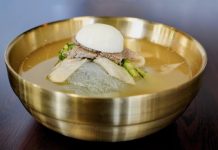
āPinot blanc is pinot grigio with more character.ā
When youāve been married to someone long enough, itās easy to predict what heāll say in certain circumstances. After nearly a dozen years of marriage, I can accurately forecast whatās about to come out of my husbandās mouth when myriad topics come up ā including pinot blanc.
With its tropical and/or tree fruit flavors and often crisp, refreshing character, this white mutation of pinot noir has a perpetual place on our home wine rack. But behind the bar, I often see consumers eschewing pinot blanc for the more familiar pinot grigio ā until I gently prod them to give the former a try.
According to the University of California-Davis, pinot blanc has grown in the Alsace region of France since the 16th century. Elsewhere in the world, youāll find pinot blanc in Italy, Austria, Hungary, Burgundy, California, and Oregon.
The grape seems to have a lukewarm reputation among wine experts. Karen MacNeil, author of The Wine Bible, writes that pinot blanc āgenerally makes good, not great, wines.ā British wine critic Jancis Robinson describes the varietal as āuseful, rather than exciting.ā
Creating Intrigue
But many Michigan winemakers would beg to differ. Bryan Ulbrich, winemaker at Left Foot Charley in Traverse City, goes so far as to declare Michiganās pinot blanc as āthe best.ā
āI honestly believe our pinot blanc is the most interesting in the world,ā he says. āMuch of the world uses it as a blender because it has a reputation for being one-dimensional. In Michigan, we get a three-dimensional wine that is stirring intrigue around the country.ā
Coenraad Stassen, winemaker at Brys Estate Vineyard and Winery on the Old Mission Peninsula, says he appreciates the āvery elegant and tropical flavorsā of pinot blanc, touting its ability to pair well with summer dishes and lighter fare.
Jenn Bourgeault, tasting room manager at Blustone Vineyards on the Leelanau Peninsula, has a quirky nickname for their pinot blanc: āunicorn wine.ā
āItās the one varietal that we have the least amount of vines planted, so production is limited,ā she says. āItās here and gone before you know it, like magic. Then, after it disappears, you can only dream about it and tell others how magical it was.
āI love the tropical fruit notes, the creamier finish, and the versatility. This is amazing with or without food.ā
Marie-Chantal Dalese, CEO of Chateau Chantal on the Old Mission Peninsula, is also a fan of pinot blanc with its creamier texture.
āThe fruit can have so many layers of pear and floral notes in a ripe year,ā she says. āWhen partnered with a lush mouthfeel, itās a home run.ā
A bonus: Even in Michiganās fickle climate, winemakers report that pinot blanc is among the more cooperative grapes to grow.
āI love pinot blanc because it is a very consistent grower, even in years where Mother Nature throws you a couple head scratches,ā says Stassen, who works with just over 2 acres of the grape at Brys Estate. āIt sets a very nice yield and ripens early to mid-season in our climate.ā
Ulbrich, who sources Pinot blanc from four Old Mission Peninsula vineyards, says pinot blanc āloves to grow in Michigan.ā
āIt likes to produce ripe clusters, which is great for the farmers, too,ā he says. āPinot blanc grown in Michigan has a distinct aromatic presence not found in Blancs from elsewhere. We also retain an exciting acidity that gives the wine life.
āMichigan pinot blanc is like no other, and we are proud to add to the worldās discussion of this noble variety.ā
A Growing Presence
Pinot blancās presence in Michigan is rising ā slowly. According to the Michigan Grape and Wine Industry Council, vineyard acreage has swelled from 10 in 2006 to 50 in 2016. Still, it pales in comparison to a slew of vinifera and hybrid grapes in Michigan, including riesling, pinot noir, pinot gris, gewĆ¼rztraminer, merlot, cabernet franc, cabernet sauvignon, vidal blanc, marechal foch, chambourcin, seyval blanc, traminette, and vignoles.
Around Michigan, pinot blanc can be found in single varietal bottlings, as well as playing a part in blends.
Ulbrich uses it for all of the above. At Left Foot Charley, he produces a single vineyard pinot blanc from OMPās Island View Vineyard; a varietal Pinot blanc that combines fruit from three other OMP vineyards; and works the grape into blends, such as his Murmur, ābecause it plays very nicely with grapes like Pinot Gris and Chardonnay.ā
Dalese says Chateau Chantal and sister winery Hawthorne Vineyard use pinot blanc to make two very different wines.
The Chateau Chantal bottling is crisp and dry, with peach and pear aromatics and light floral notes. Thereās minimal contact with the lees (dead yeast cells) to āpreserve purity of fruit,ā she says.
The Hawthorne bottling, meanwhile, is blended with just over 20 percent Auxerrois, āwhere the Blanc provides the structure and backbone, and the Auxerrois softens and rounds the edges,ā Dalese explains.
She says she finds many consumers arenāt yet acquainted with pinot blanc āĢżbut the Michigan wineries that vitify and vinify it are trying to change that.
āI feel itās a relatively unknown grape, but has the familiar feeling of āpinotā in the name,ā she says. āItās fun to describe the wine to new tasters and help them discover something new they might not have tried due to unfamiliarity. It usually goes over very well.ā
Ulbrich agrees that consumers are just beginning to learn how distinct Michigan pinot blanc can be.
āThose who already like (pinot) grigio or chardonnay are discovering a new layer in their quest for balanced, dry white wine,ā he says.
Cortney Casey is a certified sommelier and co-founder of , a website and online community that promotes the entire Michigan wine industry. Sheās also co-owner of Michigan By The Bottle Tasting Room, tasting rooms operated in partnership with multiple Michigan wineries, located in Shelby Township, Royal Oak, and Auburn Hills. Contact her at cort@michiganbythebottle.com.
|
| Ģż |
|








